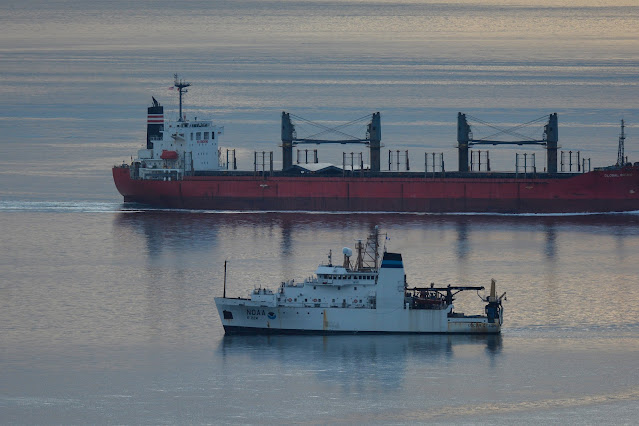 |
| Photo by Jan Hansen |
Oscar Dyson is the first in a class of ultra-quiet fisheries survey vessels built to collect data on fish populations, conduct marine mammal and seabird surveys, and study marine ecosystems.
 |
| Photo by Jan Hansen |
Homeported in Kodiak, Alaska, she operates primarily in the Bering Sea and Gulf of Alaska. On Tuesday, January 24, 2023, she spent the afternoon in the Salish Sea.
 |
| Photo by Jan Hansen |
The 208-ft. ship plays a major role in collecting data used in the management of Alaska pollock, one of the world’s largest commercial fisheries.
A stern trawler capable of conducting trawling operations to depths of nearly 6,000 feet, Oscar Dyson is equipped with sound-dampening technology, which helps NOAA scientists monitor fish populations without altering their behavior.
For acoustic surveys, scientists use the ship’s multi-frequency echo sounders to detect fish as the vessel passes over them, measuring the signal reflected by the fish to estimate their size and numbers.
Constructed to meet the National Marine Fisheries Service's specific data collection requirements, Oscar Dyson is equipped with six onboard laboratories: a wet lab, dry lab, electronics/computer lab, bio lab, acoustics lab and hydrographics lab. The ship carries a multibeam echo sounder that acquires data on the content of the water column, as well as mapping and characterizing the sea floor.
Launched in 2003 and commissioned in 2005, the ship is named after Alaskan fisherman Oscar Dyson, a pioneer in Alaska’s fishing industry for half a century before his death in 1995. A well-known fishing activist and an industry advisor to government, Dyson was dedicated to improving the industry for the many Alaskans who make their living at sea. The ship is homeported in Kodiak, Alaska.

No comments:
Post a Comment
We encourage the thoughtful sharing of information and ideas. We expect comments to be civil and respectful, with no personal attacks or offensive language. We reserve the right to delete any comment.